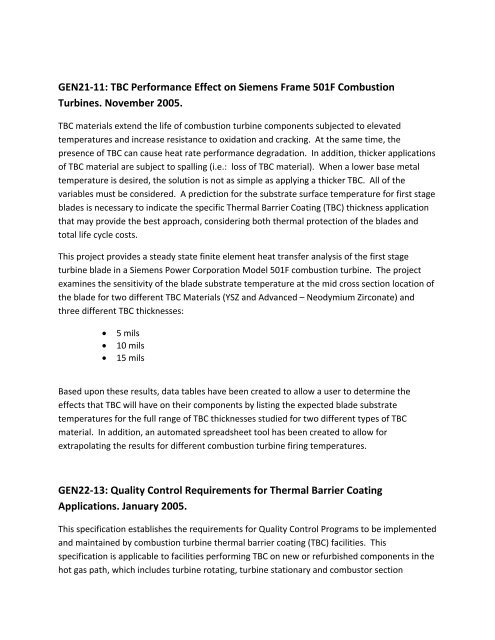GE94-02: Repair Flow Testing and Calibration Procedures for ...
GE94-02: Repair Flow Testing and Calibration Procedures for ...
GE94-02: Repair Flow Testing and Calibration Procedures for ...
Create successful ePaper yourself
Turn your PDF publications into a flip-book with our unique Google optimized e-Paper software.
GEN21‐11: TBC Per<strong>for</strong>mance Effect on Siemens Frame 501F Combustion<br />
Turbines. November 2005.<br />
TBC materials extend the life of combustion turbine components subjected to elevated<br />
temperatures <strong>and</strong> increase resistance to oxidation <strong>and</strong> cracking. At the same time, the<br />
presence of TBC can cause heat rate per<strong>for</strong>mance degradation. In addition, thicker applications<br />
of TBC material are subject to spalling (i.e.: loss of TBC material). When a lower base metal<br />
temperature is desired, the solution is not as simple as applying a thicker TBC. All of the<br />
variables must be considered. A prediction <strong>for</strong> the substrate surface temperature <strong>for</strong> first stage<br />
blades is necessary to indicate the specific Thermal Barrier Coating (TBC) thickness application<br />
that may provide the best approach, considering both thermal protection of the blades <strong>and</strong><br />
total life cycle costs.<br />
This project provides a steady state finite element heat transfer analysis of the first stage<br />
turbine blade in a Siemens Power Corporation Model 501F combustion turbine. The project<br />
examines the sensitivity of the blade substrate temperature at the mid cross section location of<br />
the blade <strong>for</strong> two different TBC Materials (YSZ <strong>and</strong> Advanced – Neodymium Zirconate) <strong>and</strong><br />
three different TBC thicknesses:<br />
• 5 mils<br />
• 10 mils<br />
• 15 mils<br />
Based upon these results, data tables have been created to allow a user to determine the<br />
effects that TBC will have on their components by listing the expected blade substrate<br />
temperatures <strong>for</strong> the full range of TBC thicknesses studied <strong>for</strong> two different types of TBC<br />
material. In addition, an automated spreadsheet tool has been created to allow <strong>for</strong><br />
extrapolating the results <strong>for</strong> different combustion turbine firing temperatures.<br />
GEN22‐13: Quality Control Requirements <strong>for</strong> Thermal Barrier Coating<br />
Applications. January 2005.<br />
This specification establishes the requirements <strong>for</strong> Quality Control Programs to be implemented<br />
<strong>and</strong> maintained by combustion turbine thermal barrier coating (TBC) facilities. This<br />
specification is applicable to facilities per<strong>for</strong>ming TBC on new or refurbished components in the<br />
hot gas path, which includes turbine rotating, turbine stationary <strong>and</strong> combustor section


